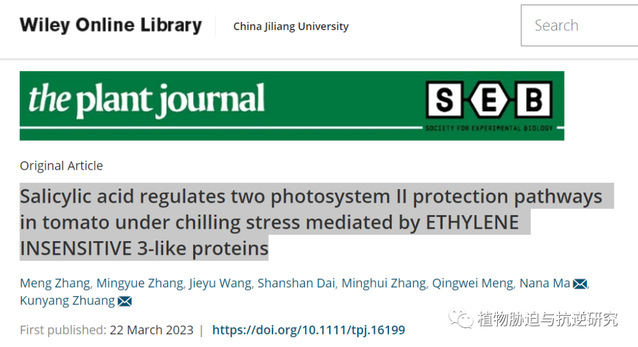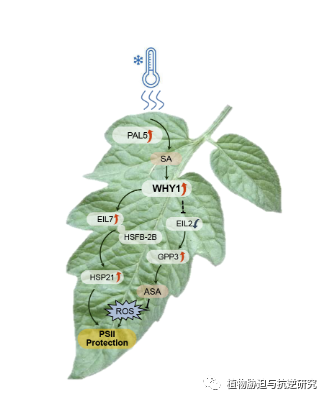山东农大孟庆伟团队庄焜扬/马娜娜在Plant J发表的研究论文《Salicylic acid regulates two photosystem II protection pathways in tomato under chilling stress mediated by ETHYLENE INSENSITIVE 3-like proteins》。

冷胁迫严重损害光合作用,并激活植物的一系列分子反应。先前的研究表明,在番茄中,乙烯不敏感3(EIN3)和EIN3样(EILs)蛋白介导乙烯信号传导并降低植物对冷冻的耐受性。然而,在低温胁迫下,EIN3/EIL介导的光保护途径的具体分子机制尚不清楚。
在本研究中,作者发现水杨酸(SA)通过SlEIL2和SlEIL7参与PSII保护。在低温胁迫下,苯丙氨酸解氨酶基因SlPAL5在SA的产生中起着重要作用,SA也诱导WHIRY1(SlWHY1)的转录。由此产生的SlWHY1的积累在低温胁迫下激活SlEIL7的表达。增加的SlEIL7随后结合并阻断热休克因子SlHSFB-2B的抑制结构域,释放其对热休克蛋白21(HSP21)表达的抑制,以维持PSII的稳定性。
此外,SlWHY1间接抑制SlEIL2的表达,使L-半乳糖-1-磷酸磷酸酶3(SlGPP3)得以表达。随后较高的SlGPP3丰度促进了抗坏血酸的积累,从而清除了低温胁迫下产生的活性氧(ROS),从而保护了PSII。
本研究的研究表明,SlEIL2和SlEIL7通过两种不同的SA反应机制在低温胁迫下保护PSII:一种涉及抗氧化剂抗坏血酸,另一种涉及光保护伴侣蛋白HSP21。

Chilling stress seriously impairs photosynthesis and activates a series of molecular responses in plants. Previous studies have shown that ETHYLENE INSENSITIVE 3 (EIN3) and EIN3-like (SlEILs) proteins mediate ethylene signaling and reduce plant tolerance to freezing in tomato (Solanum lycopersicum). However, the specific molecular mechanisms underlying a EIN3/EILs-mediated photoprotection pathway under chilling stress are unclear. Here, we discovered that salicylic acid (SA) participates in PSII protection via SlEIL2 and SlEIL7. Under chilling stress, the phenylalanine ammonia lyase gene SlPAL5 plays an important role in the production of SA, which also induces WHIRLY1 (SlWHY1) transcription. The resulting accumulation of SlWHY1 activates SlEIL7 expression under chilling stress. Increased SlEIL7 then binds to and blocks the repression domain of the heat shock factor SlHSFB-2B, releasing its inhibition of Heat shock protein 21 (HSP21) expression to maintain PSII stability. In addition, SlWHY1 indirectly repressed SlEIL2 expression, allowing the expression of L-GALACTOSE-1-PHOSPHATE PHOSPHATASE3 (SlGPP3). The ensuing higher SlGPP3 abundance promoted the accumulation of ascorbic acid, thus scavenging reactive oxygen species (ROS) produced upon chilling stress and thus protecting PSII. Our study demonstrates that SlEIL2 and SlEIL7 protect PSII under chilling stress via two different SA response mechanisms: one involving the antioxidant ascorbic acid, and the other involving the photoprotective chaperone protein HSP21.


 返回顶端
返回顶端


